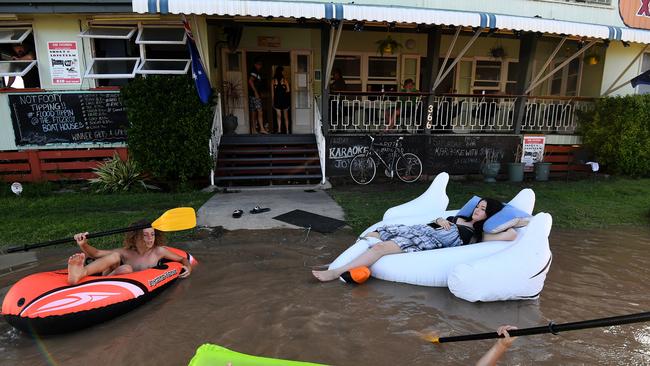Engineer warned of danger from Wivenhoe dam
BRISBANE City Council's top flood engineer recommended a decade ago that Wivenhoe Dam be operated differently as a bigger buffer against flooding.
BRISBANE City Council's top flood engineer recommended a decade ago that Wivenhoe Dam be operated differently to ensure a much larger buffer against flooding, documents obtained under Freedom of Information show.
Engineer Ken Morris warned in an internal report, Brisbane River Flooding, that the existing and longstanding Queensland government policy of operating the dam at full supply level meant its capacity to mitigate floods was significantly compromised.
Mr Morris, the council's principal engineer for flood management, also warned a decade ago that the council's development controls meant thousands of residents were unaware they would be severely hit by floods during rainfall events that were much smaller than those predicted to occur once in 100 years, despite assurances that their properties would not be affected.
Premier Anna Bligh pledged yesterday that the operations and requirements of the Queensland government-owned Wivenhoe Dam would be the subject of early and forensic scrutiny by the commission of inquiry that has been set up.
Engineers and hydrology experts who have been examining data on river height, dam flow rates and weather systems have told The Australian the dam stored far too much water in its flood compartment over the weekend of January 8-9.
They said the Brisbane flood was largely attributable to the dam's operators releasing unprecedented and unnecessarily vast volumes of water on January 11 after they lost their flood buffer because the dam had not been drawn down significantly over the weekend before the huge rainfall dump.
The performance of the dam's operators has been described as first-class by SEQWater Grid managers, who said Wivenhoe had done a remarkable job in mitigating the flood.
Water Grid managers said they had at all times operated according to the manual and rigid rules.
The flooding and deaths in Toowoomba and the Lockyer Valley were unrelated because that catchment is separate to Wivenhoe's 7000 square kilometre catchment.
The commission of inquiry's dam expert, Phil Cummins, has pledged that the inquiry will examine the public policy settings that required the dam to be operated at 100 per cent of its capacity for urban supply.
The dam's operation at 100 per cent continues today despite the extreme rainfall and flooding in Queensland in recent months, the Bureau of Meteorology's warnings last year of intense rain with a confirmed new La Nina weather phase after years of drought-causing El Nino, and the completion of the state's multi-billion-dollar drought-proofing Water Grid.
Mr Morris, who did not return calls yesterday while directing flood recovery operations in the devastated suburbs of Brisbane, has noted in official reports before the Water Grid was established that Wivenhoe Dam could be comfortably operated below its full supply level.
Mr Morris suggested that operating Wivenhoe at 75 per cent and using the balance as additional flood storage would make a significant difference to the level in the Brisbane River during any flooding.
"The potential exists to either reduce the water storage capacity of the dam to provide additional flood storage or increase the flood storage capacity of the dam by raising the wall of the dam," Mr Morris wrote.
"Such work could increase the effectiveness of the dam considerably.
"In Brisbane, big events on the Brisbane River are associated with big wet periods.
"It only takes 40mm of rainfall runoff to fill 25 per cent of the storage, so even if the dam was drawn down it would soon recover and most likely recover before the beginning of a one-in-100-year event."
The six largest floods recorded in Brisbane's history since white settlement were in either January or February in the years 1841, 1844, 1893 (twice), 1974 and this year.
Pressure on Wivenhoe Dam to run at 100 per cent was reinforced six weeks ago, despite the onset of the wet season, when the Queensland government announced new cost-saving policies, including putting the new Tugun desalination plant on standby, saving $10 million a year.
The policies meant that Wivenhoe Dam continued to run at 100 per cent full supply (about 1.15 million megalitres), leaving its flood storage compartment of about 1.45 million megalitres to handle any extreme rainfall events.
Weeks after cabinet and disaster management groups were briefed by the Bureau of Meteorology to expect highly unusual rainfall in the 2011 wet season, Queensland Treasurer Andrew Fraser and Natural Resources Minister Stephen Robertson announced "major reforms to the southeast Queensland water supply grid to help reduce rising household water bills".




To join the conversation, please log in. Don't have an account? Register
Join the conversation, you are commenting as Logout